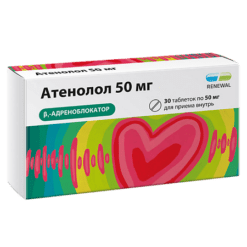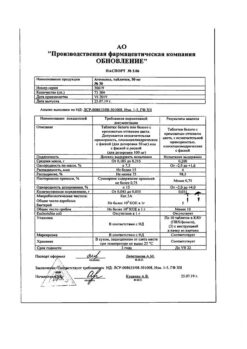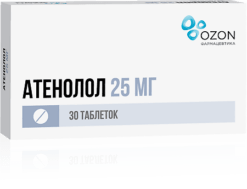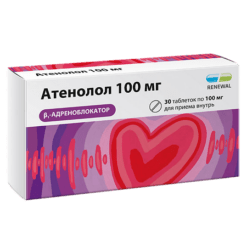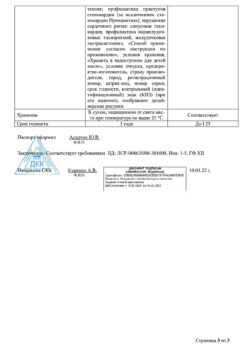No products in the cart.
Atenolol-Teva, tablets 50 mg 30 pcs
€1.56 €1.00
Out of stock
(E-mail when Stock is available)
Description
Pharmacotherapeutic group
Beta1-adrenoblocker selective
ATX code: C07AB03
Pharmacodynamics:
It has antianginal antihypertensive and antiarrhythmic effects. Does not have membrane stabilizing and intrinsic sympathomimetic activity. Reduces catecholamine-stimulated formation of cAMP from ATP decreases intracellular Ca2+ flux. During the first 24 hours after oral administration, against a background of decreased cardiac output, there is a reactive increase in total peripheral vascular resistance, which during 1-3 days gradually returns to the baseline and then gradually decreases. Hypotensive effect is associated with a decrease in the minute blood volume by reducing the activity of renin-angiotensin system baroreceptor sensitivity and the effect on the central nervous system. Its hypotensive effect is manifested by both decrease of systolic and diastolic blood pressure (BP) and decrease of stroke and minute blood volume.
In medium therapeutic doses, it has no effect on peripheral arterial tone. Hypotensive effect lasts for 24 h with regular use and stabilizes by the end of the second week of treatment.
The antianginal effect is determined by decrease of myocardial oxygen demand as a result of decrease of heart rate (prolongation of diastole and improvement of myocardial perfusion) and contractility and decrease of myocardial sensitivity to sympathetic stimulation. It reduces heart rate (HR) at rest and during exercise. By increasing left ventricular end-diastolic pressure and increasing ventricular muscle fiber stretch may increase oxygen demand especially in patients with chronic heart failure.
The antiarrhythmic action is manifested by suppression of sinus tachycardia and is associated with the elimination of arrhythmogenic sympathetic effects on the cardiac conduction system by reducing the rate of spread of excitation through the sinoatrial node and lengthening the refractory period. Suppresses conduction of impulses in the antegrade and, to a lesser extent, in the retrograde direction through the AV (atrioventricular) node and through additional conduction pathways.
The negative chronotropic effect appears 1 h after administration reaches a maximum after 2-4 h lasts up to 24 h.
Decreases sinus node automatism decreases HR decelerates AV conduction decreases myocardial contractility decreases myocardial oxygen demand. Reduces myocardial excitability. When used in medium therapeutic doses, it has less effect on the smooth muscle of the bronchi and peripheral arteries than non-selective beta-adrenoblockers.
It increases survival of patients who have had myocardial infarction (reduces the incidence of ventricular arrhythmias and angina attacks).
It does not practically weaken the bronchodilator effect of isoproterenol.
In contrast to non-selective beta-adrenoblockers when administered in medium therapeutic doses, it has less pronounced effect on organs containing beta2-adrenoreceptors (pancreas-skeletal muscles smooth muscles of peripheral arteries of bronchi and uterus) and on carbohydrate metabolism; intensity of atherogenic action does not differ from that of propranololol. To a lesser extent, it has a negative batmo- chrono- and dromotropic effect. When used in high doses (more than 100 mg/day) it has a blocking effect on both beta-adrenoreceptor subtypes.
Pharmacokinetics:
Absorption from the gastrointestinal tract – fast incomplete (50-60%) bioavailability – 40-50% time to reach maximum plasma concentration – 2-4 hours. Poorly penetrates through the blood-brain barrier and passes in small amounts through the placental barrier and into breast milk. Binding with blood plasma proteins is 6-16%. It is practically not metabolized in the liver. The elimination half-life is 6-9 hours (it increases in elderly patients). Excreted by kidneys through glomerular filtration (85-100% unchanged). Renal dysfunction is accompanied with prolongation of the half-life period and cumulation: 16-27 hours when creatinine clearance is less than 35 ml/min/173 m2 and creatinine clearance less than 15 ml/min/173 m2 – more than 27 hours (it is necessary to decrease the doses). It is excreted during hemodialysis.
Indications
Indications
– Arterial hypertension;
– prevention of angina attacks (except for Prinzmetal angina);
– cardiac rhythm disorders: sinus tachycardia prevention of supraventricular tachyarrhythmias ventricular extrasystoles.
Active ingredient
Active ingredient
Composition
Composition
1 tablet contains:
The active ingredient is atenolol 50.00 mg,
auxiliary substances: microcrystalline cellulose 81.00 mg, carbomer (934 P) 0.40 mg, sodium lauryl sulfate 4.00 mg, calcium hydrophosphate dihydrate 34.00 mg, croscarmellose sodium (type A) 20.00 mg, colloidal silicon dioxide 0.60 mg, talc 1.00 mg, hydrogenated vegetable oil (type I) 7.00 mg, magnesium stearate 2.00 mg.
How to take, the dosage
How to take, the dosage
Prescribe orally before eating without chewing and drinking a small amount of liquid.
Atenololol is started with 50 mg atenolol once daily. It takes 1 -2 weeks of therapy to achieve a stable hypotensive effect. If hypotensive effect is not sufficiently pronounced, the dose is increased to 100 mg per dose. Further increase of the dose is not recommended because it is not accompanied by the strengthening of the clinical effect.
Stenocardia and sinus tachycardia.The initial dose is 50 mg per day. If optimal therapeutic effect is not achieved within a week, the dose is increased to 100 mg per day. Sometimes it is possible to increase the dose to 200 mg once a day. In elderly patients and patients with impaired renal excretory function the dosage regimen should be adjusted. In patients with renal failure, it is recommended to correct the dose depending on creatinine clearance. There is no significant cumulation of Atenolol in patients with renal insufficiency when creatinine clearance is not higher than 35 ml/min/173 m2 (normal values are 100-150 ml/min/173 m2). The following maximum doses are recommended for patients with renal insufficiency:
Creatinine clearance (mL/min/173 m2)
Atenolol half-life(h)
Maximum dose
15-35
16-27
50 mg daily or 100 mg every other day
less than 15
/p>
more than 27
50 mg every other day or 100 mg once every 4 days
In patients on hemodialysis, Atenolol is indicated at 25 or 50 mg/day immediately after each dialysis treatment, which should be performed in a hospital setting because there may be a decrease in BP. In elderly patients, the initial single dose is 25 mg (can be increased while monitoring BP HR).
Enlargement of daily dose more than 100 mg is not recommended because the therapeutic effect does not increase and the probability of side effects increases.
It is not advisable to prescribe more than once daily because atenolol acts within 24 hours.
Lowering the dose if withdrawal is planned is done gradually in 1/4 doses every 3 to 4 days.
Interaction
Interaction
In concomitant use of atenolol with insulin oral hypoglycemic drugs – their hypoglycemic effect is enhanced. When concomitant use with antihypertensive agents of different groups or nitrates the hypotensive effect is increased. Concomitant use of atenolol and verapamil (or diltiazem) may cause mutual enhancement of the cardiodepressant effect.
The hypotensive effect is weakened by estrogens (sodium retention) and nonsteroidal anti-inflammatory drugs glucocorticosteroids. Concomitant use of atenolol and cardiac glycosides increases the risk of bradycardia and atrioventricular conduction disorders.
Concomitant use of atenololol with reserpine methyldopa clonidine verapamil may result in marked bradycardia.
Concomitant intravenous administration of verapamil and diltiazem may induce cardiac arrest; nifedipine may lead to a significant decrease in BP.
The concomitant administration of atenolol with ergotamine xanthine derivatives decreases its efficacy.
If combined use of atenololol and clonidine is discontinued, treatment with clonidine continues for several more days after atenololol withdrawal Concurrent use with lidocaine may decrease its excretion and increase the risk of lidocaine toxicity.
The use together with phenothiazine derivatives contributes to increased serum concentrations of each drug.
Phenytoin when administered with IV general anesthesia drugs (hydrocarbon derivatives) increases the severity of cardiodepressive effects and the likelihood of BP reduction.
In co-administration with eufylline and theophylline mutual suppression of therapeutic effects is possible.
The concomitant use with MAO inhibitors is not recommended due to the significant increase in the hypotensive effect of treatment interval between MAO inhibitors and atenolol must be at least 14 days.
Allergens used for immunotherapy or allergen extracts for skin tests increase the risk of severe systemic allergic reactions or anaphylaxis.
Inhalation anesthetics (hydrocarbon derivatives) increase the risk of myocardial dysfunction and arterial hypertension.
Amiodarone increases the risk of bradycardia and inhibition of AV conduction. Cimetidine increases plasma concentrations (inhibits metabolism). Iodine-containing radiopaque drugs for IV administration increase the risk of anaphylactic reactions.
Longens the effects of nondepolarizing myorelaxants and the anticoagulant effect of coumarins.
Tri- and tetracyclic antidepressants antipsychotic drugs (neuroleptics) ethanol sedatives and sleeping pills increase central nervous system depression.
Special Instructions
Special Instructions
Monitoring of patients taking Atenolol should include monitoring of HR and BP (at the beginning of treatment – daily then once every 3-4 months) blood glucose content in diabetic patients (once every 4-5 months). In elderly patients it is recommended to monitor kidney function (once every 4-5 months).
The patient should be instructed on how to calculate heart rate and should be advised to consult a physician if the heart rate is less than 50 bpm.
In thyrotoxicosis, atenolol may mask certain clinical signs of thyrotoxicosis (e.g., tachycardia). Abrupt withdrawal in patients with thyrotoxicosis is contraindicated because it can exacerbate the symptoms. In diabetes mellitus can mask tachycardia caused by hypoglycemia. Unlike non-selective beta-adrenoblockers it does not practically increase insulin-induced hypoglycemia and does not delay recovery of blood glucose to normal concentration.
In patients with coronary heart disease (CHD), abrupt withdrawal of beta-adrenal blockers may increase the frequency or severity of angina attacks, so stopping atenolol for CHD patients should be done gradually.
In comparison with non-selective beta-adrenoblockers, cardioselective beta-adrenoblockers have less effect on lung function, yet in obstructive airway disease atenolol is prescribed only if absolutely indicated. If it is necessary to prescribe them in some cases the use of beta2-adrenomimetics may be recommended.
Patients with bronchospastic diseases may be prescribed cardioselective adrenoblockers in cases of intolerance and/or ineffectiveness of other hypotensive drugs, but the dosage should be strictly observed. Overdose is dangerous with the development of bronchospasm.
Particular caution is required if surgical intervention under anesthesia is required in patients taking atenolol. The drug should be discontinued 48 hours before the intervention. As an anesthetic, a drug with as little negative inotropic effect as possible should be chosen.
In concomitant use of atenolol and clonidine, atenolol should be discontinued several days before clonidine in order to avoid the withdrawal symptoms of the latter. Hypersensitivity reactions may become more pronounced and there may be no effect from usual doses of epinephrine against a background of a history of aggravated allergy.
The catecholamine-lowering medications (e.g., reserpine) may increase the effects of beta-adrenoblockers, so patients taking these combinations of medications should be under constant medical monitoring for evidence of marked BP reduction or bradycardia.
In elderly patients with increasing bradycardia (less than 50 beats/min), arterial hypotension (systolic BP below 100 mmHg), atrioventricular block, bronchospasm, ventricular arrhythmias, and severe hepatic or renal impairment, the dose should be reduced or treatment should be stopped.
It is recommended that therapy be discontinued if depression is caused by taking beta-adrenoblockers.
If intravenous verapamil administration is necessary, this should be done at least 48 hours after atenolol administration.
The use of atenolol may decrease tear fluid production, which is important in patients who wear contact lenses.
The treatment should not be abruptly discontinued because of the risk of severe arrhythmias and myocardial infarction. The drug should be discontinued before testing blood and urine catecholamine levels of normetanephrine and vanillylmindalic acid; antinuclear antibody titers.
In smokers, the effectiveness of beta-adrenoblockers is lower.
At the time of treatment, refrain from engaging in potentially hazardous activities that require increased concentration and rapid psychomotor reactions.
Contraindications
Contraindications
Hypersensitivity to the drug cardiogenic shock atrioventricular (AV) block of degree II-III. expressed bradycardia (heart rate less than 40 beats/min.) sinus node weakness syndrome sinoauricular block acute or chronic decompensated heart failure) cardiomegaly without signs of heart failure Prinzmetal’s angina arterial hypotension (if used in myocardial infarction, systolic BP less than 100 mm Hg) lactation concomitantly taking monoamine oxidase inhibitors (MAO).
Younger than 18 years of age – the efficacy and safety of the drug have not been established.
Diabetes mellitus metabolic acidosis hypoglycemia allergic reactions in history chronic obstructive pulmonary disease (including Pulmonary emphysema) Degree I AV blockade Chronic heart failure (compensated) Peripheral occlusive vascular disease (“intermittent claudication” Raynaud’s syndrome) pheochromocytoma Liver failure Chronic renal insufficiency Myasthenia gravis thyrotoxicosis Depression (including anamnesis) Psoriasis elderly age pregnancy and lactation
Side effects
Side effects
Cardiovascular system:development (aggravation) of symptoms of chronic heart failure (swollen ankles; dyspnea) atrioventricular conduction arrhythmia bradycardia marked decrease in BP orthostatic hypotension palpitations.
Central nervous system:dizziness decreased ability to concentrate decreased reaction speed somnolence or insomnia depression hallucinations increased fatigue headache weakness “nightmares” dreams anxiety confusion or short-term memory loss paresthesias in the extremities (in patients with “intermittent” claudication and Raynaud’s syndrome) muscle weakness seizures.
Gastrointestinal tract:dry mouth nausea vomiting diarrhea abdominal pain constipation change in taste.
Respiratory system:dyspnea bronchospasm apnea nasal congestion.
Hematological reactions:thrombocytic purpura anemia (aplastic) thrombosis.
Endocrine system:decreased potency decreased libido hyperglycemia (in patients with insulin-independent diabetes) hypoglycemia (in patients receiving insulin) hypothyroidism.
Skin reactions:urticaria dermatitis skin itching photosensitivity increased sweating skin hyperemia exacerbation of the course of psoriasis reversible alopecia.
Sensory organs:visual impairment decrease in tear fluid secretion dry and sore eyes conjunctivitis.
Fetal effects:intrauterine growth retardation hypoglycemia bradycardia.
Laboratory indicators:agranulocytosis leukopenia increased activity of “liver” enzymes hyperbilirubinemia.
Others:back pain arthralgia “withdrawal” syndrome (tachycardia increased frequency of attacks of angina pectoris increased BP, etc.).
The frequency of side effects increases with increasing the dose of the drug.
Overdose
Overdose
Symptoms: marked bradycardia AV block of II-III degree increasing symptoms of heart failure excessive decrease in BP difficult breathing bronchospasm dizziness fainting arrhythmia ventricular extrasystole cyanosis finger nails or palms convulsions.
Treatment: gastric lavage and administration of adsorptive medications; if bronchospasm occurs, inhalation or intravenous administration of the beta2-adrenomimetic salbutamol is indicated. In bradycardia AV conduction disorders – intravenous injection of 1-2 mg of epinephrine atropine or placement of a temporary pacemaker; in ventricular extrasystole – lidocaine (Class 1A drugs are not used); in BP decrease – the patient should be in Trendelenburg position. If there are no signs of pulmonary edema – IV plasma exchange solutions if ineffective – injection of epinephrine dopamine dobutamine; in chronic heart failure – cardiac glycosides diuretics glucagon; in convulsions – IV diazepam. Dialysis may be performed.
Pregnancy use
Pregnancy use
Atenolol crosses the placental barrier and is detected in umbilical cord blood. No studies on the use of atenolol in the first trimester have been conducted and therefore the possibility of a damaging effect on the fetus cannot be excluded. For the treatment of arterial hypertension in the third trimester of pregnancy the drug is used under close medical supervision. The use of Atenolol during pregnancy may cause fetal growth disturbance. Atenolol should be administered to pregnant or planning to become pregnant only when the benefit to the mother exceeds the potential risk to the fetus, especially in the first and second trimesters of pregnancy since beta-blockers decrease placental perfusion, which may lead to fetal death or immaturity and premature delivery. In addition, side effects such as hypoglycemia and bradycardia can occur in both the fetus and the newborn.
Pregnant women should prescribe atenolol only when the benefit to the mother exceeds the potential risk to the fetus. Atenolol is excreted with breast milk, so it should only be taken exceptionally and with great caution during lactation.
Similarities
Similarities
Additional information
| Shelf life | 3 years. Do not use after the expiration date. |
|---|---|
| Conditions of storage | Store at a temperature not exceeding 25°C. Store out of the reach of children. |
| Manufacturer | Pliva Hrvatska d.o.o., Croatia |
| Medication form | pills |
| Brand | Pliva Hrvatska d.o.o. |
Other forms…
Related products
Buy Atenolol-Teva, tablets 50 mg 30 pcs with delivery to USA, UK, Europe and over 120 other countries.


